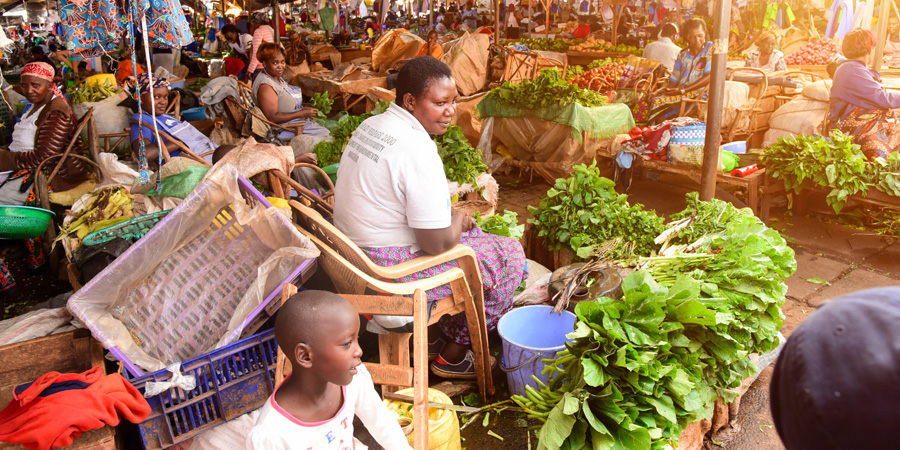Fight against food insecurity in sub-Saharan Africa: educating about the indigenous vegetables improves the food security.

As food security continues to worsen in sub-Saharan Africa with an increase of 46 million of hungry people between 2019 and 2021, it becomes urgent to design food system that improves dietary quality and reduce the prevalence of nutrition insecurity by increasing total energy and micronutrient intake. Producing, understanding, and consuming African indigenous vegetables (AIV) may be part of the solution. An evaluation of a programmatic impact of a nutrition, culinary and production interventions, on nutrition security was done in Western Kenya from 2016 till 2019. The authors conclude that coupled nutrition, culinary, and production interventions could create a protective effect against seasonal fluctuations, as dry and wet season and the availability and affordability of AIV and hence nutrition security.
Nutrition security; defined as having consistent access, availability, and affordability of foods and beverages that promote well-being and prevent disease is required to promote diet-related health outcomes (Mozaffarian D et al., 2021). In sub-Saharan Africa, the prevalence of undernutrition had remained stagnant for many years. In Kenya, the prevalence of food insecurity (moderate or severe) in the population increased of 15.5% in 5 years : from 53% in 2014-2016 to 68.5% in 2018-2020 (FAO, IFAD, UNICEF, WFD, 2021). The attribute of AIVs such as Solanum scabrum, Cleome gynandra, etc. may allow a sustainable food system : they are culturally accepted, nutritionally dense, and adapted to local environment production with little to no inputs (Kamga et al.,2013; Chivenge et al, 2015 ; Muhanji et al, 2011).
Education about diet (nutrition, healthy habits) and promotion of AIVs production are good strategies for overcoming malnutrition (Caspi et al., 2017; Jamnadass and al., 2011). Through a long-term survey calculating the Household Hunger Scale (HHS) and Women’s Dietary Diversity Score (WDD) , a recent study included 500 families (Merchant et al, 2023), investigates how seasonality may influence the impact of education interventions on nutrition security, diet quality and AIVs consumption.
Interventions about nutrition lead to more diversified diet
During the observation period, the population was divided in 4 groups:
- control,
- intervention on nutrition,
- intervention on production,
- intervention on nutrition and production.
At the end of the study, there was a significant decrease of WDD for all the population, and as the same time an observed decrease of other outcome variables. Even if the results are not significant, the sample that received intervention on nutrition and production have a better WDD relative to control (5.1+/- 1.8 vs 4.2 +/- 1.5). As regards the consumption of AIVs, there was a significant difference in consumption patterns between the groups: the 2 groups that had intervention about nutrition reported to have most diversity in diet and consume more AIVs relative to control.
Respondents reported that they have a perceived improvement quality. “The diet awareness” is the reason for improving diet; in addition, “production” and “income” were reported as reasons for improving diet quality.
Bring production closer to purchasing and consumption
Even if there is a significant shift in location used to source the food items at the beginning and at the end of the study with less sourcing from their own or other farm, the respondents reported an overall increase and adequate supply of key AIV’s, particularly for households that receive education about production. AIVs are less sensitive to shocks as compared to introduced crops. The AIVs may be a resilient commodity and stabilizing their availability throughout the year remains a challenge (Altieri et al., 2012).
Smallholder farmers often supply the local village markets as they have been historically unable to access the larger value-chain (Ngugi et al., 2007). Proximity to household, retail outlets and farm gate outlets are the main determinants of choices of food supply (Gido et al., 2017). In the study, increasing the source of food from the town markets underscores the limited availability and affordability of AIVs within the local value-chain.
Coupling interventions about nutrition, culinary and productions are the most effective strategies to protect against seasonal fluctuations
The influence of culinary, and production interventions on nutrition security among smallholders’ farmers Western Kenya were evaluated. The findings explained that coupling intervention about nutrition, culinary and production are the most effective and could create a protective effect against seasonal fluctuations in the availability and affordability of AIVs by a higher WDD. Moreover, most of the participants reported to supply adequate AIV’s; however, the availability with proximity may affect the results.
Even if the context did not allow to significantly translate the effects of the various interventions, particularly on the WDD, the results of this study remain positive. As mentioned in the introduction, food security has declined sharply in sub-Saharan Africa. Nevertheless, in this context, results are promising. Future programming and policy should focus on promoting the availability, accessibility, acceptability, affordability of improved agronomic practices. Agricultural training and extension services should incorporate nutrition and culinary interventions that emphasize the importance of farmers prioritizing harvest for their household’s consumption.
Based on: Merchant E. and al., an evaluation of nutrition, culinary, and production interventions using African indigenous vegetables on nutrition security among smallholders farmers in Wester Kenya, 2023.
- Education of AIVs may help small farmers to have better diet.
- Interventions coupling education on nutrition and production give the best results on WDDS concerns.
- Accessibility of AIVs may be a limit in future.
